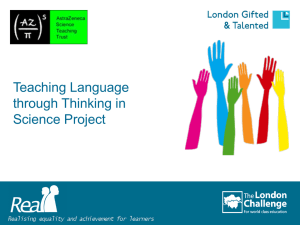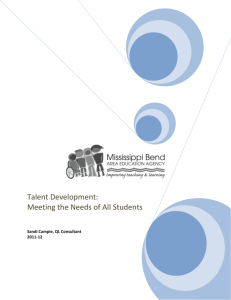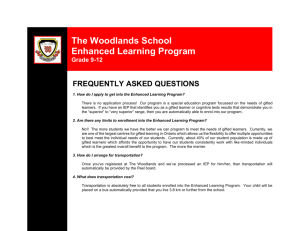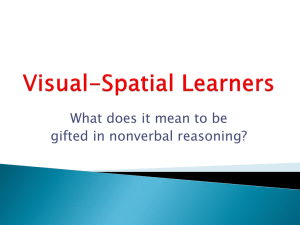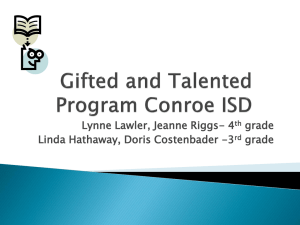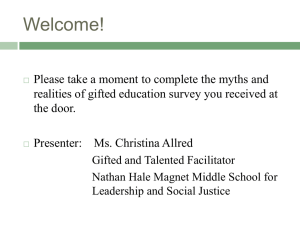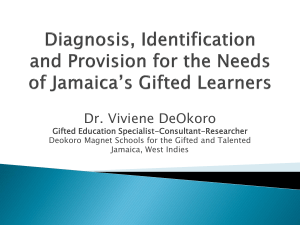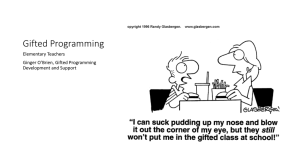Mallard Creek Elementary Learning Immersion Talent Development
advertisement
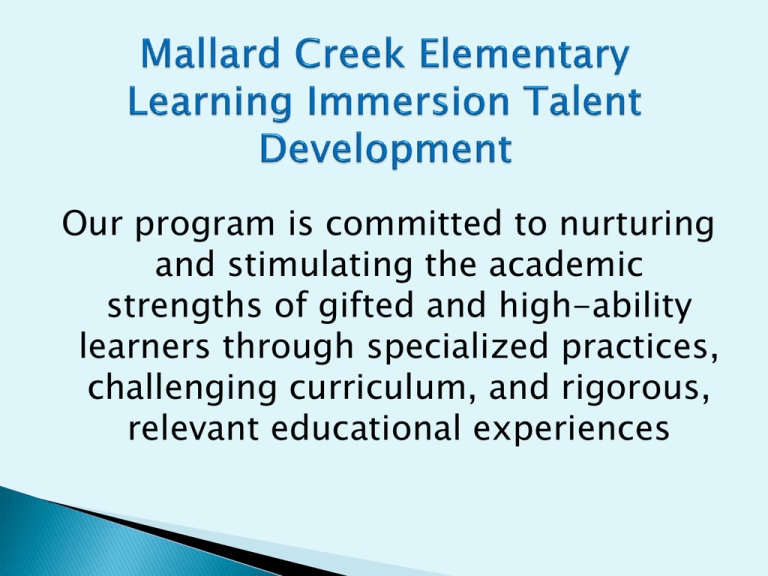
Our program is committed to nurturing and stimulating the academic strengths of gifted and high-ability learners through specialized practices, challenging curriculum, and rigorous, relevant educational experiences Rich learning environment Safe and supportive Supporting the social/emotional needs Enrich their learning through engaging extracurricular activities Well-trained educators and staff on addressing the different needs of gifted learners Role of the LI/TD Facilitator Lead the implementation, monitoring of an effective magnet program for meeting the needs of potentially gifted, high-achieving, and gifted students serve as an advocate on behalf of gifted and high-achieving learners support and collaborate with teachers in the development of effective lesson plans that meet the needs of learners in our school monitor the use of best practices model and coach teachers in the development of best practices select and provide supplemental resources to support topics, content, concepts that are being taught facilitate activities and events to provide students with opportunities to extend their learning beyond the regular classroom experiences serve as a liaison between the school program and the TD Dept and Magnet Office. serve as a spokesperson for our program by keeping parents informed work collaboratively with parents serve on the Administrative team to help facilitate a successful school environment lead TD Committee assess and evaluate students for the gifted program maintain all paperwork/activities associated with being an LI/TD magnet Work with individual or groups of students Learning Immersion ◦ ◦ ◦ ◦ ◦ Assess the needs of students and use assessment to drive instruction Differentiate based on the needs of students Provide opportunities for students to experience creative and critical thinking opportunities to enrich their learning Plan lessons with support with colleagues and facilitators to address the needs of students with supplemental resources if needed Communicate with parents and administration Attend professional development that supports the needs (academic, artistic, social/emotional, behavioral, etc.) of students within the program Talent Development • • • • • • • Working towards or hold Academically/Intellectually Gifted (AIG) Licensure Serve identified gifted or potentially gifted students within a daily classroom setting Plan and work collaboratively with grade-level colleagues to ensure all academic needs of the learner are addressed (i.e.-Response to Instruction (RTI) Time Assess the needs of their students and differentiate based on their needs Enrich and accelerate learning using best practices for gifted learners Ongoing communication with parents, facilitators, and administrators Attend professional development that supports the needs (academic, artistic, social/emotional, behavioral, etc.) of students within the program Common Core and Essential Standards as our foundations Well-balanced literacy program High quality mathematics Integrating of social studies and science Infusing of the arts within the regular classroom instruction Integration of technology as a student tool Teaching reading (Skills & Strategies) Vocabulary ◦ Wordly Wise Program(3-5 TD Classes) Curriculum designed for Gifted learners ◦ William & Mary Language Arts program (use the book as a guide, not just use of novels) ◦ Junior Great Books ◦ Touchpeebles Reading Program (Inquiry-based Program) ◦ A to Z Text based on student levels ◦ Navigators Book Sets & Teacher Guides Differentiated Literature Circles RTI Paidea Seminars Projects Use of pre-assessments to determine student’s needs Use of data to drive instruction Differentiation of instruction within the classroom (based on student’s needs, interest, learning preferences , Multiple Intelligences) and during Response to Instruction (RTI) time Consistent behavior plans (differentiate plans where needed); maintaining documentation to address student needs Open communication and collaborative relationship with parents Collaborative team effort when addressing needs of students (involve Facilitator, Dean of Students, Counselor, and other Support staff as needed) -Continued teacher professional development Primary Use of Math Investigations Program and CMS-created units Supplemental resources TERC Math Investigations Units Navigators’ Math Units Mentoring Minds Mentoring Mathematical Minds (M3) Units Kathy Richardson Marcy Cook Cards Differentiation -Menus, Contracts, Compacts Problem Solver Series Primary Math Challenge & Math Challenge Books (Great for Differentiating Levels) Essential Standards as a Guide Inquiry-based learning Note booking Use of Expository text Problem-Based Learning Experiences Integration of hands-on experiences, technology-based learning and exploration, virtual field experiences and field trips Projects Quarterly Meetings with Parents based on different subjects Support groups to address social emotional needs Regular class meetings to address different needs associated with the gifted learner Collaboration with parents, support staff and administrative team Student monitoring and evaluation, goal setting of academic and behavioral progress Possible workshop Student-Led Conferences Math Olympiad (4-5) Math Club (K-3) Science Olympiad (K-5) Chess (K-5) National Elementary Honor Society (4-5) Geography/Tar Heel Club (3-5) Arts’ Clubs (Drama, Music, Art, Dance (K-5) Safety Patrol (5) Student Government Association (3-5) Magnet Ambassadors (4-5) ◦ Completion of Parent Survey ◦ Open for General Questions A Team Effort takes all of Us! Thank you for Being an Active Part of the Team. Presenter, Christina Forney Principal, Natalie Lowe
